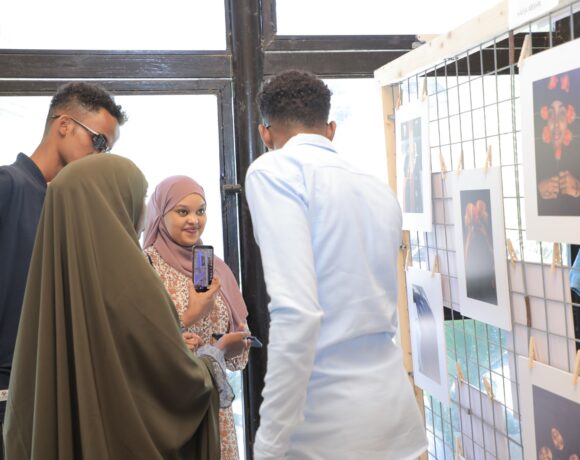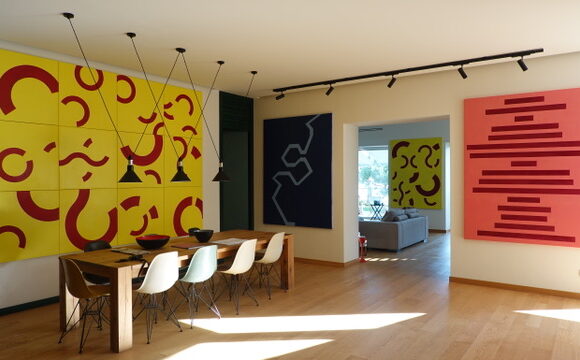“Aboriginality” is a word invented in the 1950s by the indigenous of Australia to emphasize their cultural diversity and their struggles. From the beginning of the colonization at the end of the XVII century, Australia had been defined as “Terra nullius”, an uninhabited land that belonged to no one. This thought led to the denial of the human state of the Australian indigenous and therefore to the impossibility for them to claim ownership of the territory, which was granted only in 1967.
The Aboriginalities exhibition at the Royal Museums of Fine Arts of Belgium shows around 150 works by Aboriginal artists collected over twenty years by Marie Philippson. Aboriginal art refers to both pre-colonialism and contemporary art influenced by traditional culture. It tells of the creation of the world – the “Dreamtime” – and the relation between humans and the Earth. Originally conceived to be made and experienced in hidden places, in the early 1970s, Aboriginal artistic expression became a vehicle to spread and bring out their political, social and economic struggles. The first ones to use art as a tool for communication and freedom were the artists of the Papunya Tula community. They used acrylic colors and canvas for the first time and this knowledge is passed down from generation to generation by members of the same community.
The brothers Thomas (1964) and Walala (1972) lived until the age of twenty without any contact with the West, moving naked from one water source to another and carrying only spears and boomerangs. In 1984, they were transferred to Kiwieekurrat, and there they learned painting according to the new canons. In “Tingari” (2010), Thomas Tjapaltjarri represents the Tingari ancestors, a nomadic group who traditionally used to travel across Australia. The aborigines, in fact, think that the world was created by the Ancestors, spiritual and mythical beings who spread life during their peregrinations.
The artists depict areas from which they come from, where they were born, or which have particularly affected their life; this highlights the importance of the topographical dimension. In “Grand Mother Country”, Gabriella Possum Nungarrayi – eldest daughter of Clifford Possum Tjapaltjarri, one of Australia’s most famous aboriginal artist – depicts the Gold Country, her grandmother’s homeland where she spent a lot of time during her childhood. The painting represents the landscape from above: pools of water, rocks, forests, and female figures (represented with a letter “u”) are transformed into signs that refer to something primordial.
Aboriginal art is both ancestral and contemporary. Spirituality is at the center of this practice bringing out the relation between the human beings and the universe. For the subjects of her paintings, Maisie Campbell Napaltjarri is inspired by the places dedicated to ceremonies. In “Myyma Immaku” (2011), she tells the “Dream of water” story by evoking the ancesters’ places through concentric forms. Water is in fact the most important source of life and is protected by the figure of the “Rainbow serpent”, depicted by Timothy Wulanjbir on a eucalyptus leaf with the rarrk technique, a polychrome cross hatch.
In “Broad Shield Design” (1996) by Jonathan Kumintjarra Brown, the ritual origin of the painting is highlighted through a line symbolically drawn on the ground with the end of a stick and destined to be faded away at the end of the ceremony. Repeated concentric circles are visible, typical of the Pitjantjatjara’s decorations which, if reproduced on the shields, become protective symbols.
Aboriginal Australians live together with nature in total spiritual communion. The term “aboriginality” is formed from the words “aborigine” and “originality” and does not indicate a new form of primitivism but a possible future different from the concept of modernity that we know. The simple and repetitive signs of Aboriginal art give life to an ancestral and universal language, capable of communicating to everyone and thus allowing this culture to preserve itself. It is an emotional art, rich in colors and shapes that capture and refer to new and continuous interpretations.
Martina Matteucci
Info:
Aboriginalities
01.04 – 01.08.2021
Royal Museums of Fine Arts of Belgium
Rue de la Régence / Regentschapsstraat 3
1000 Brussels
 Emily Kame Kngwarreye (1910-1996), Anooralya Yam Dreaming, 1994, acrylic on canvas, 70 x 90 cm. Collection Philippson © Courtesy of the artist, photo: Vincent Everarts
Emily Kame Kngwarreye (1910-1996), Anooralya Yam Dreaming, 1994, acrylic on canvas, 70 x 90 cm. Collection Philippson © Courtesy of the artist, photo: Vincent Everarts
 Sally Gabori (1924-2015), Big Crocodile, 2005, acrylic on canvas, 91 x 211 cm. Collection Philippson © Courtesy of the artist, photo: Vincent Everarts
Sally Gabori (1924-2015), Big Crocodile, 2005, acrylic on canvas, 91 x 211 cm. Collection Philippson © Courtesy of the artist, photo: Vincent Everarts
 Johnny Warangkula Tjupurrula (1925-2001), Dingo Camp at Tinki, 1973, acrylic on canvas, 61 x 79 cm. Collection Philippson © Courtesy of the artist, photo: Vincent Everarts
Johnny Warangkula Tjupurrula (1925-2001), Dingo Camp at Tinki, 1973, acrylic on canvas, 61 x 79 cm. Collection Philippson © Courtesy of the artist, photo: Vincent Everarts

Graduated in “Communication and Didactics of Art ” at the Brera Academy of Fine Arts, she then obtained a two-year Master degree in “Visual Arts and Curatorial Practices” at NABA in Milan. She has a strong passion for culture and art because she really thinks they are important tools of innovation and social regeneration. She works with different magazines and contemporary art institutions.






NO COMMENT